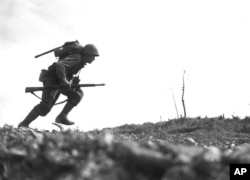In Okinawa, the 70th anniversary of Japan’s surrender to American led forces in World War II still stirs painful memories for survivors. It also offers key insight into why many claim that the brutal Battle of Okinawa led to the use of atomic weapons on Japanese cites.
The invasion of Okinawa was the last and largest of the Pacific island battles of World War II. It included an American naval armada of over a thousand ships and over 170,000 American troops.
The Japanese forces numbered close to 100,000.
Despite their bigger numbers and firepower, the American led forces encountered strong resistance. The Japanese fought from heavily fortified positions. Kamikaze pilots flew suicidal missions and destroyed or heavily damaged dozens of American ships.
The sustained fighting that raged for 82 days destroyed villages, incinerated forests, and killed close to 200,000 people.
In Okinawa the nature of the war was changing. The Japanese under General Mitsuru Ushijima employed a strategy of a guerilla war of attrition.
“His goal here is not to win. He has no intentions of winning the battle of Okinawa. His intention is to bleed the American forces so bad that the United States sues for peace,” said Mark Waycaster, the curator of a small museum on a marine base in Okinawa that preserves historical wartime photographs and memorabilia.
Nagasaki and Hiroshima
Americans realized after Okinawa that a full-scale invasion of mainland Japan would lead to repeated battles, resulting in untold destruction and loss of life before victory over Tokyo could be achieved.
The decision to drop atomic bombs on Nagasaki and Hiroshima, President Harry Truman was quoted to say at the time was to prevent “an Okinawa from one end of Japan to the other.”
Today on Okinawa the horrific loss of life suffered during the battle, nearly one third of the civilian population, is still remembered by residents and marked by memorials.
The Himeyuri Peace Museum tells the story of nearly 200 schoolgirls who were conscripted to work as nurses for the Japanese military. Many died in the fighting.
Shimabukuro Yoshiko was only 17 when she was forced to attend to wounded Japanese in a cave that was converted into a battlefield hospital. She recalls being constantly afraid and overwhelmed, trying to treat the mounting number of injured soldiers with minimal medical supplies.
She said the Japanese warned the girls that if captured by the Americans they would be brutally raped and killed.
As the Americans advanced Yoshiko was injured in an explosion. Her initial reaction was to hope that death finds here before the Americans.
“I didn’t think I would survive. I thought, how am I going to die? I wondered in my head and in my heart would I die instantly? And that is what I was praying for to God,” Yoshiko said.
Instead she said an American soldier appeared, treated her wound and saved her life.
“And then I thought, is this the enemy? I heard they were devils and I saw his face and he looked nice and said ‘I’m going to help you,’” she said.
For many pacifists in Okinawa such memories of wartime devastation and loss of life justify their opposition to the continued U.S. presence on the islands and of conservative Japanese efforts to reinvigorate its military. Others believe the Battle of Okinawa warranted the use of the atomic bomb and exemplifies the need for maintaining a strong military presence in the region.











